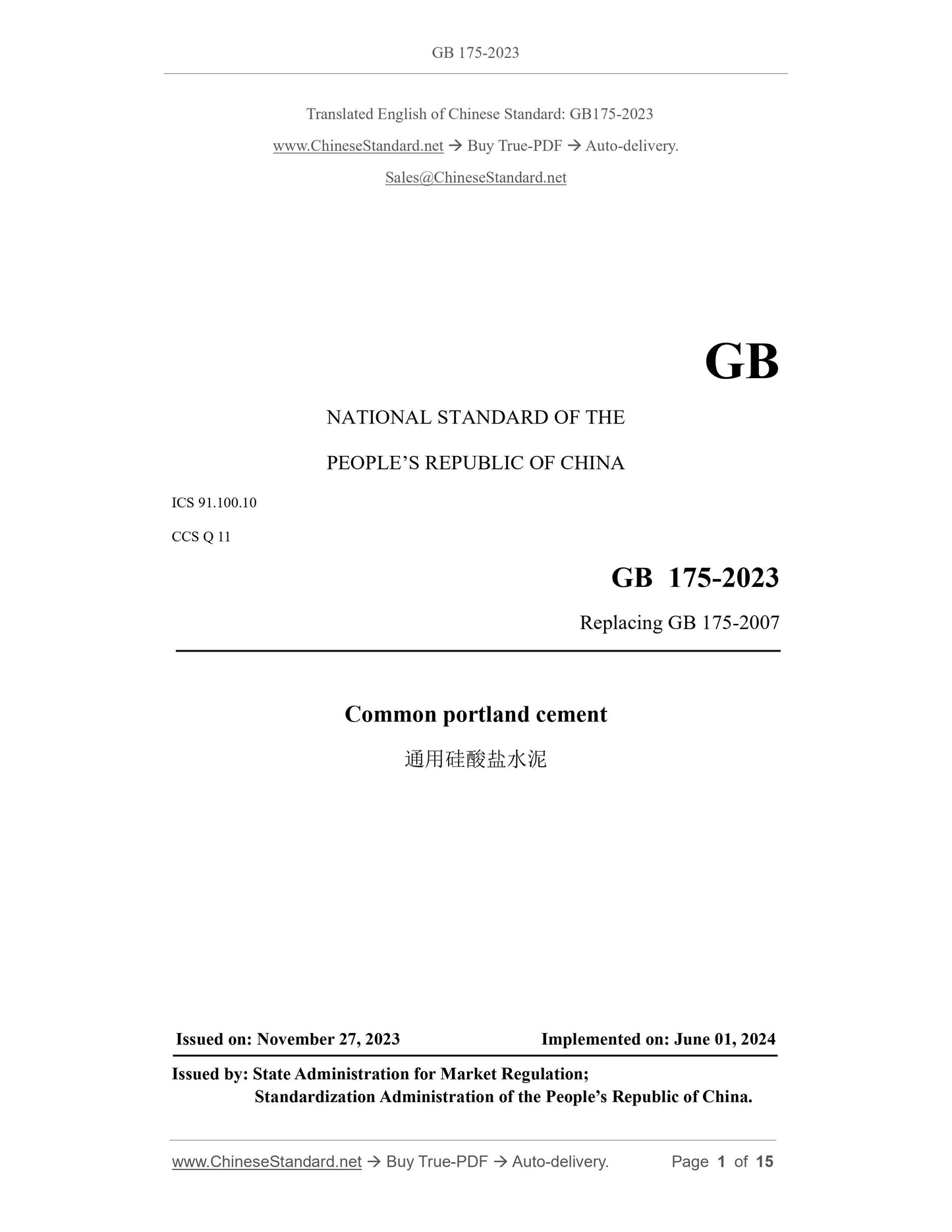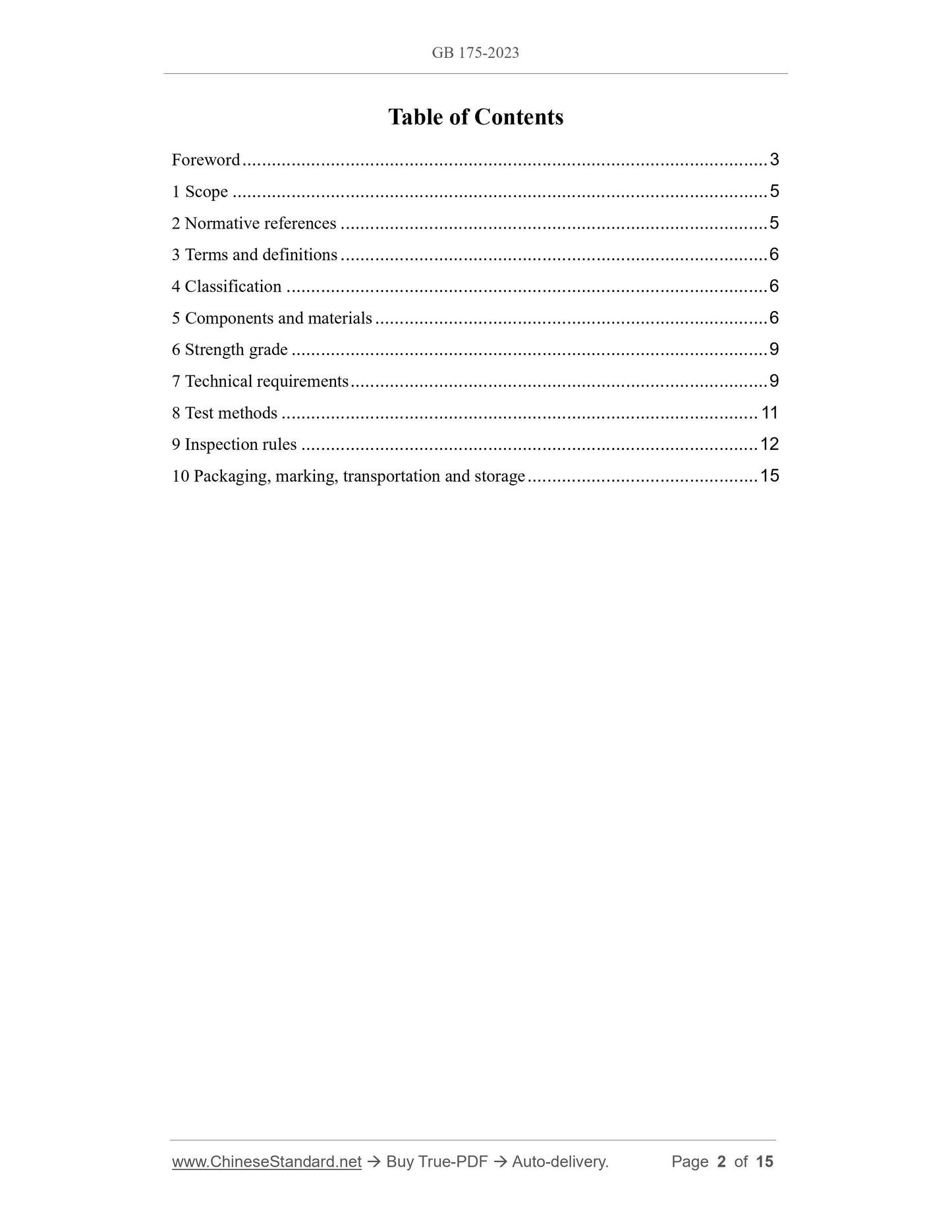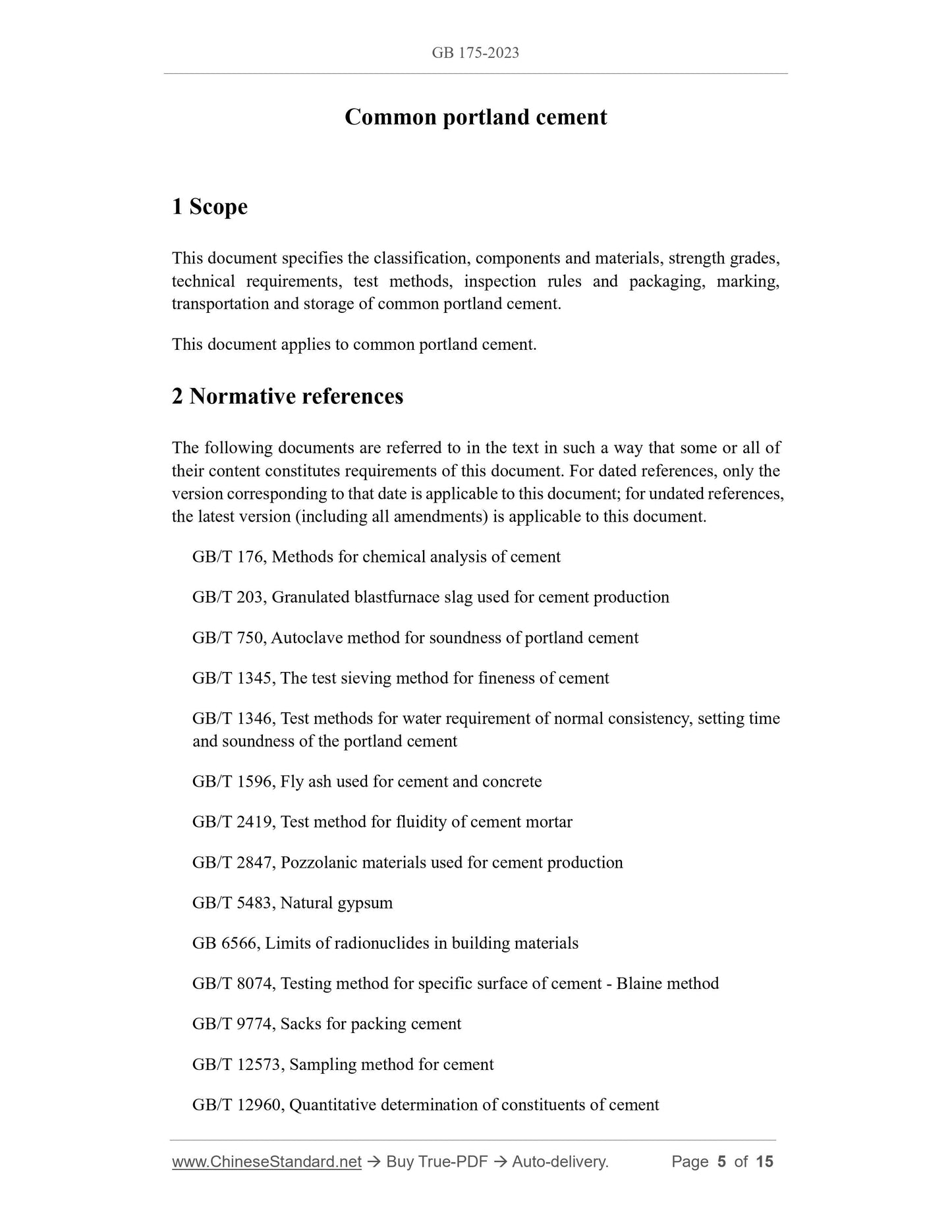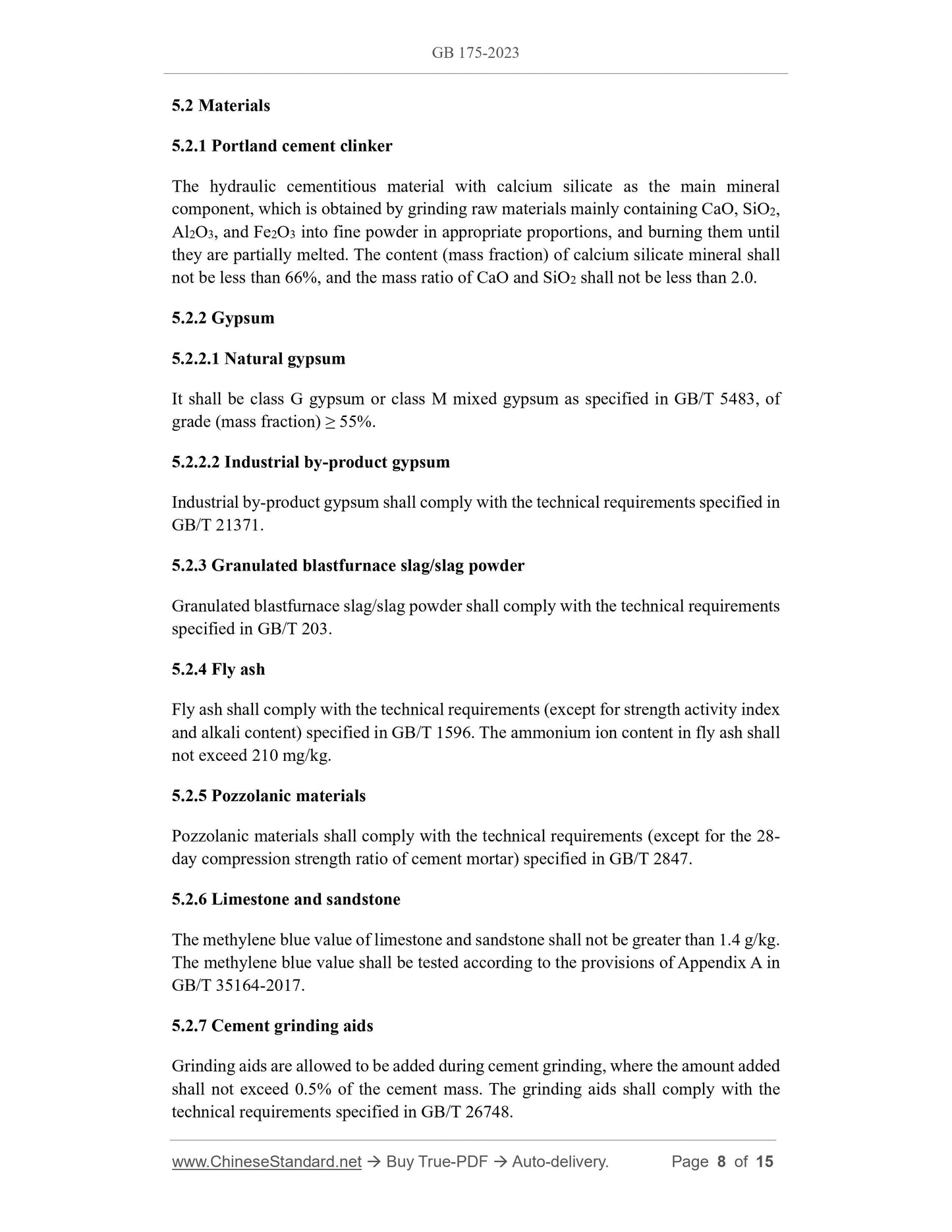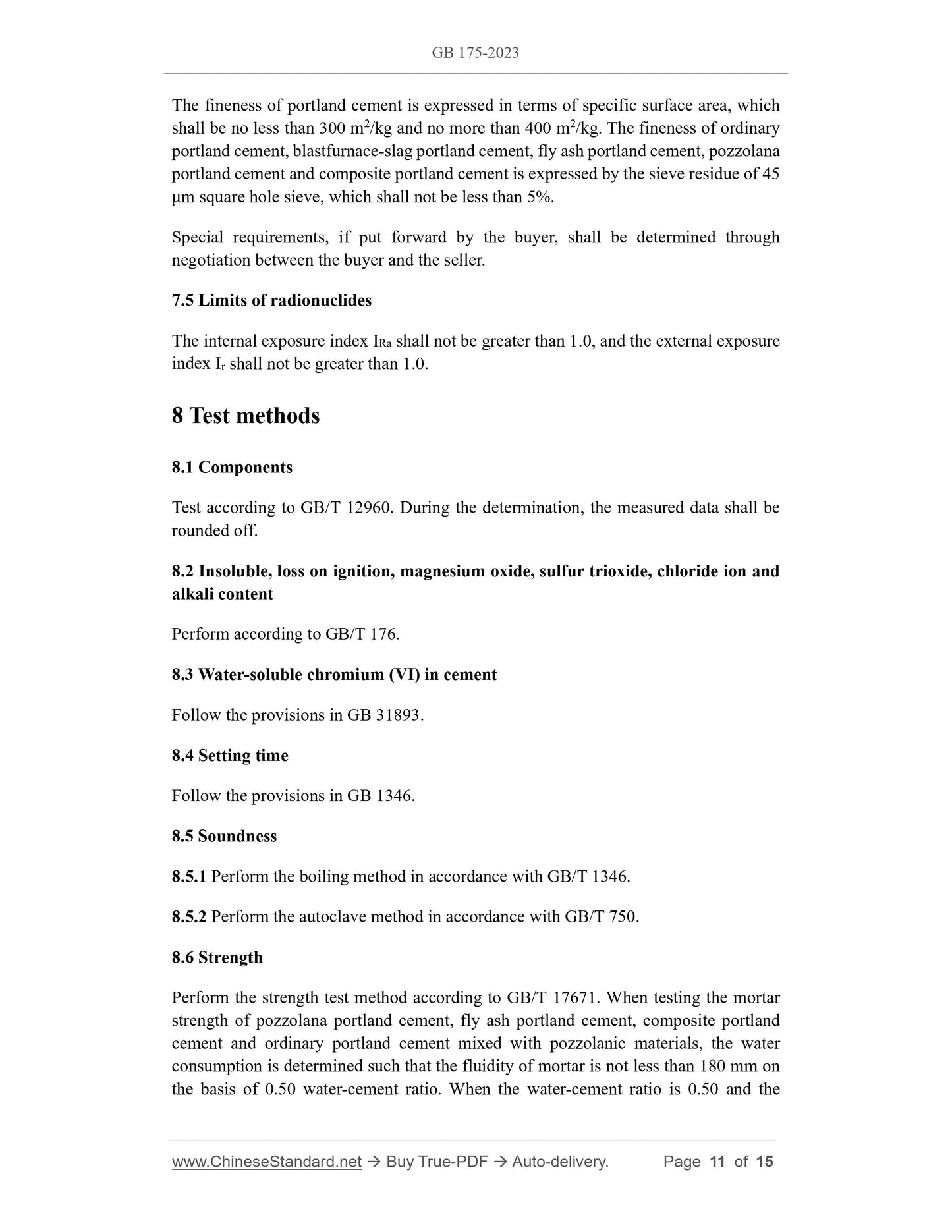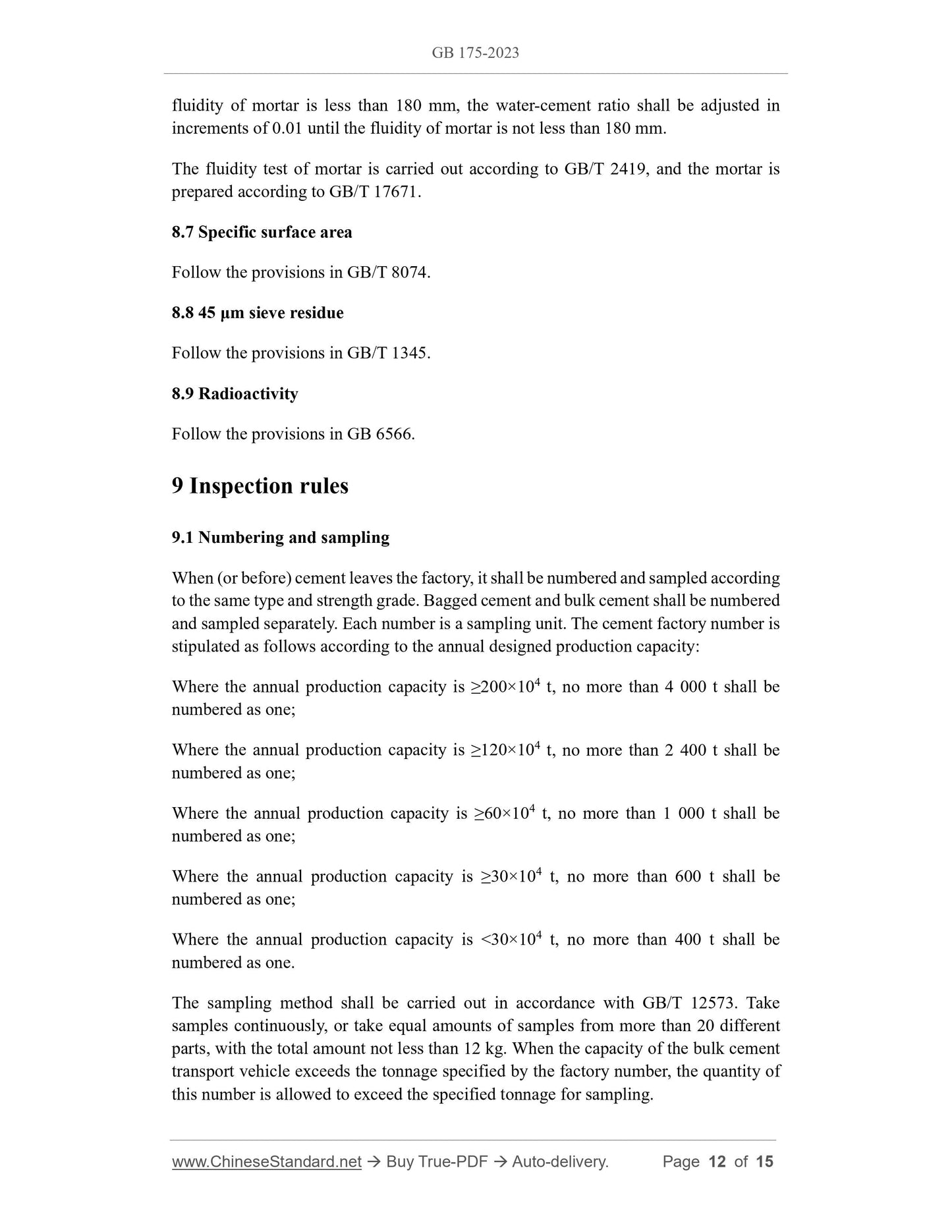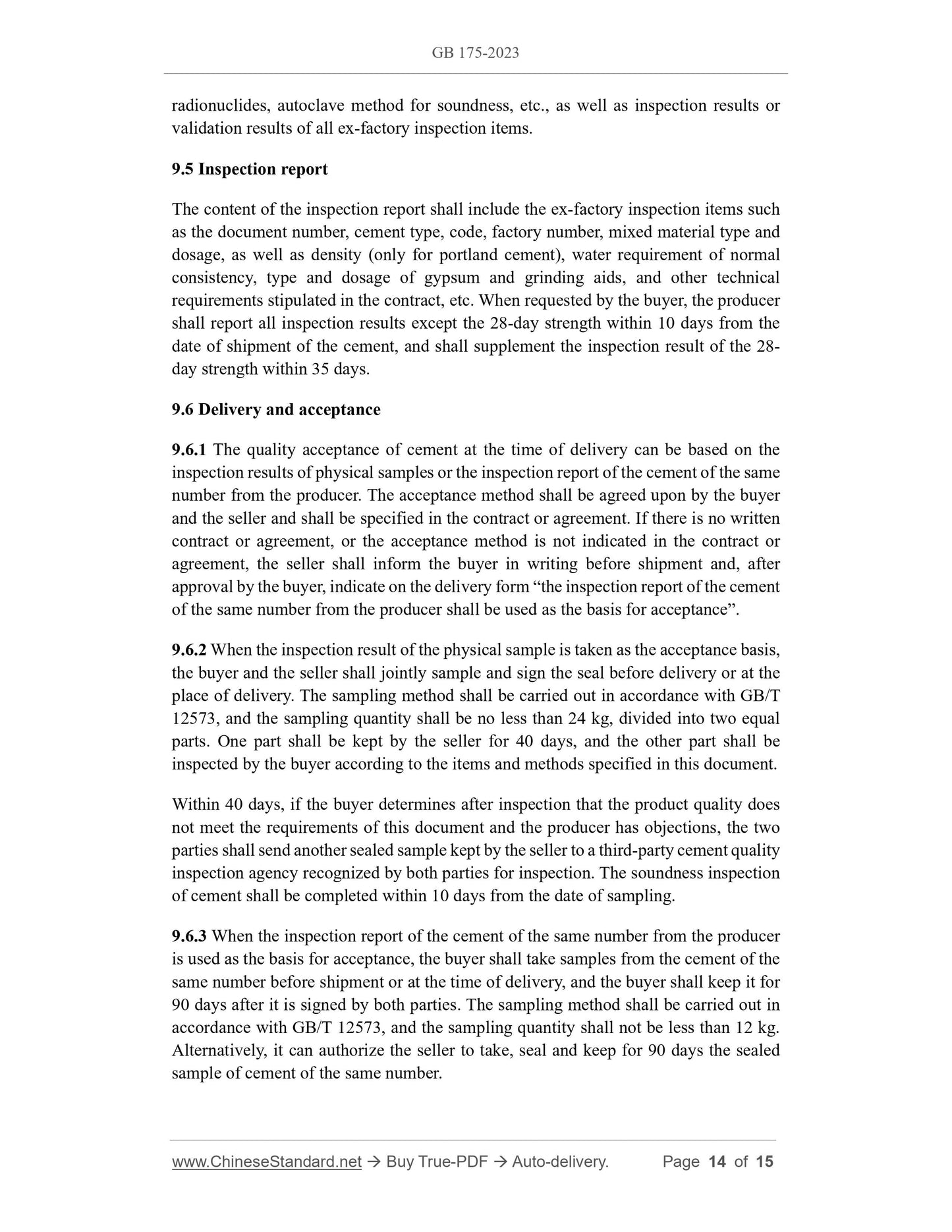1
/
จาก
7
PayPal, credit cards. Download editable-PDF and invoice in 1 second!
GB 175-2023 English PDF (GB175-2023)
GB 175-2023 English PDF (GB175-2023)
ราคาปกติ
$145.00 USD
ราคาปกติ
ราคาโปรโมชัน
$145.00 USD
ราคาต่อหน่วย
/
ต่อ
ค่าจัดส่งที่คำนวณในขั้นตอนการชำระเงิน
ไม่สามารถโหลดความพร้อมในการรับสินค้าด้วยตนเองได้
Delivery: 3 seconds. Download true-PDF + Invoice.
Get QUOTATION in 1-minute: Click GB 175-2023
Historical versions: GB 175-2023
Preview True-PDF (Reload/Scroll if blank)
GB 175-2023: Common portland cement
GB 175-2023
GB
NATIONAL STANDARD OF THE
PEOPLE’S REPUBLIC OF CHINA
ICS 91.100.10
CCS Q 11
Replacing GB 175-2007
Common portland cement
ISSUED ON: NOVEMBER 27, 2023
IMPLEMENTED ON: JUNE 01, 2024
Issued by: State Administration for Market Regulation;
Standardization Administration of the People’s Republic of China.
Table of Contents
Foreword ... 3
1 Scope ... 5
2 Normative references ... 5
3 Terms and definitions ... 6
4 Classification ... 6
5 Components and materials ... 6
6 Strength grade ... 9
7 Technical requirements ... 9
8 Test methods ... 11
9 Inspection rules ... 12
10 Packaging, marking, transportation and storage ... 15
Common portland cement
1 Scope
This document specifies the classification, components and materials, strength grades,
technical requirements, test methods, inspection rules and packaging, marking,
transportation and storage of common portland cement.
This document applies to common portland cement.
2 Normative references
The following documents are referred to in the text in such a way that some or all of
their content constitutes requirements of this document. For dated references, only the
version corresponding to that date is applicable to this document; for undated references,
the latest version (including all amendments) is applicable to this document.
GB/T 176, Methods for chemical analysis of cement
GB/T 203, Granulated blastfurnace slag used for cement production
GB/T 750, Autoclave method for soundness of portland cement
GB/T 1345, The test sieving method for fineness of cement
GB/T 1346, Test methods for water requirement of normal consistency, setting time
and soundness of the portland cement
GB/T 1596, Fly ash used for cement and concrete
GB/T 2419, Test method for fluidity of cement mortar
GB/T 2847, Pozzolanic materials used for cement production
GB/T 5483, Natural gypsum
GB 6566, Limits of radionuclides in building materials
GB/T 8074, Testing method for specific surface of cement - Blaine method
GB/T 9774, Sacks for packing cement
GB/T 12573, Sampling method for cement
GB/T 12960, Quantitative determination of constituents of cement
5.2 Materials
5.2.1 Portland cement clinker
The hydraulic cementitious material with calcium silicate as the main mineral
component, which is obtained by grinding raw materials mainly containing CaO, SiO2,
Al2O3, and Fe2O3 into fine powder in appropriate proportions, and burning them until
they are partially melted. The content (mass fraction) of calcium silicate mineral shall
not be less than 66%, and the mass ratio of CaO and SiO2 shall not be less than 2.0.
5.2.2 Gypsum
5.2.2.1 Natural gypsum
It shall be class G gypsum or class M mixed gypsum as specified in GB/T 5483, of
grade (mass fraction) ≥ 55%.
5.2.2.2 Industrial by-product gypsum
Industrial by-product gypsum shall comply with the technical requirements specified in
GB/T 21371.
5.2.3 Granulated blastfurnace slag/slag powder
Granulated blastfurnace slag/slag powder shall comply with the technical requirements
specified in GB/T 203.
5.2.4 Fly ash
Fly ash shall comply with the technical requirements (except for strength activity index
and alkali content) specified in GB/T 1596. The ammonium ion content in fly ash shall
not exceed 210 mg/kg.
5.2.5 Pozzolanic materials
Pozzolanic materials shall comply with the technical requirements (except for the 28-
day compression strength ratio of cement mortar) specified in GB/T 2847.
5.2.6 Limestone and sandstone
The methylene blue value of limestone and sandstone shall not be greater than 1.4 g/kg.
The methylene blue value shall be tested according to the provisions of Appendix A in
GB/T 35164-2017.
5.2.7 Cement grinding aids
Grinding aids are allowed to be added during cement grinding, where the amount added
shall not exceed 0.5% of the cement mass. The grinding aids shall comply with the
technical requirements specified in GB/T 26748.
The fineness of portland cement is expressed in terms of specific surface area, which
shall be no less than 300 m2/kg and no more than 400 m2/kg. The fineness of ordinary
portland cement, blastfurnace-slag portland cement, fly ash portland cement, pozzolana
portland cement and composite portland cement is expressed by the sieve residue of 45
μm square hole sieve, which shall not be less than 5%.
Special requirements, if put forward by the buyer, shall be determined through
negotiation between the buyer and the seller.
7.5 Limits of radionuclides
The internal exposure index IRa shall not be greater than 1.0, and the external exposure
index Ir shall not be greater than 1.0.
8 Test methods
8.1 Components
Test according to GB/T 12960. During the determination, the measured data shall be
rounded off.
8.2 Insoluble, loss on ignition, magnesium oxide, sulfur trioxide, chloride ion and
alkali content
Perform according to GB/T 176.
8.3 Water-soluble chromium (VI) in cement
Follow the provisions in GB 31893.
8.4 Setting time
Follow the provisions in GB 1346.
8.5 Soundness
8.5.1 Perform the boiling method in accordance with GB/T 1346.
8.5.2 Perform the autoclave method in accordance with GB/T 750.
8.6 Strength
Perform the strength test method according to GB/T 17671. When testing the mortar
strength of pozzolana portland cement, fly ash portland cement, composite portland
cement and ordinary portland cement mixed with pozzolanic materials, the water
consumption is determined such that the fluidity of mortar is not less than 180 mm on
the basis of 0.50 water-cement ratio. When the water-cement ratio is 0.50 and the
fluidity of mortar is less than 180 mm, the water-cement ratio shall be adjusted in
increments of 0.01 until the fluidity of mortar is not less than 180 mm.
The fluidity test of mortar is carried out according to GB/T 2419, and the mortar is
prepared according to GB/T 17671.
8.7 Specific surface area
Follow the provisions in GB/T 8074.
8.8 45 μm sieve residue
Follow the provisions in GB/T 1345.
8.9 Radioactivity
Follow the provisions in GB 6566.
9 Inspection rules
9.1 Numbering and sampling
When (or before) cement leaves the factory, it shall be numbered and sampled according
to the same type and strength grade. Bagged cement and bulk cement shall be numbered
and sampled separately. Each number is a sampling unit. The cement factory number is
stipulated as follows according to the annual designed production capacity:
Where the annual production capacity is ≥200×104 t, no more than 4 000 t shall be
numbered as one;
Where the annual production capacity is ≥120×104 t, no more than 2 400 t shall be
numbered as one;
Where the annual production capacity is ≥60×104 t, no more than 1 000 t shall be
numbered as one;
Where the annual production capacity is ≥30×104 t, no more than 600 t shall be
numbered as one;
Where the annual production capacity is < 30×104 t, no more than 400 t shall be
numbered as one.
The sampling method shall be carried out in accordance with GB/T 12573. Take
samples continuously, or take equal amounts of samples from more than 20 different
parts, with the total amount not less than 12 kg. When the capacity of the bulk cement
transport vehicle exceeds the tonnage specified by the factory number, the quantity of
this number is allowed to exceed the specified tonnage for sampling.
radionuclides, autoclave method for soundness, etc., as well ...
Get QUOTATION in 1-minute: Click GB 175-2023
Historical versions: GB 175-2023
Preview True-PDF (Reload/Scroll if blank)
GB 175-2023: Common portland cement
GB 175-2023
GB
NATIONAL STANDARD OF THE
PEOPLE’S REPUBLIC OF CHINA
ICS 91.100.10
CCS Q 11
Replacing GB 175-2007
Common portland cement
ISSUED ON: NOVEMBER 27, 2023
IMPLEMENTED ON: JUNE 01, 2024
Issued by: State Administration for Market Regulation;
Standardization Administration of the People’s Republic of China.
Table of Contents
Foreword ... 3
1 Scope ... 5
2 Normative references ... 5
3 Terms and definitions ... 6
4 Classification ... 6
5 Components and materials ... 6
6 Strength grade ... 9
7 Technical requirements ... 9
8 Test methods ... 11
9 Inspection rules ... 12
10 Packaging, marking, transportation and storage ... 15
Common portland cement
1 Scope
This document specifies the classification, components and materials, strength grades,
technical requirements, test methods, inspection rules and packaging, marking,
transportation and storage of common portland cement.
This document applies to common portland cement.
2 Normative references
The following documents are referred to in the text in such a way that some or all of
their content constitutes requirements of this document. For dated references, only the
version corresponding to that date is applicable to this document; for undated references,
the latest version (including all amendments) is applicable to this document.
GB/T 176, Methods for chemical analysis of cement
GB/T 203, Granulated blastfurnace slag used for cement production
GB/T 750, Autoclave method for soundness of portland cement
GB/T 1345, The test sieving method for fineness of cement
GB/T 1346, Test methods for water requirement of normal consistency, setting time
and soundness of the portland cement
GB/T 1596, Fly ash used for cement and concrete
GB/T 2419, Test method for fluidity of cement mortar
GB/T 2847, Pozzolanic materials used for cement production
GB/T 5483, Natural gypsum
GB 6566, Limits of radionuclides in building materials
GB/T 8074, Testing method for specific surface of cement - Blaine method
GB/T 9774, Sacks for packing cement
GB/T 12573, Sampling method for cement
GB/T 12960, Quantitative determination of constituents of cement
5.2 Materials
5.2.1 Portland cement clinker
The hydraulic cementitious material with calcium silicate as the main mineral
component, which is obtained by grinding raw materials mainly containing CaO, SiO2,
Al2O3, and Fe2O3 into fine powder in appropriate proportions, and burning them until
they are partially melted. The content (mass fraction) of calcium silicate mineral shall
not be less than 66%, and the mass ratio of CaO and SiO2 shall not be less than 2.0.
5.2.2 Gypsum
5.2.2.1 Natural gypsum
It shall be class G gypsum or class M mixed gypsum as specified in GB/T 5483, of
grade (mass fraction) ≥ 55%.
5.2.2.2 Industrial by-product gypsum
Industrial by-product gypsum shall comply with the technical requirements specified in
GB/T 21371.
5.2.3 Granulated blastfurnace slag/slag powder
Granulated blastfurnace slag/slag powder shall comply with the technical requirements
specified in GB/T 203.
5.2.4 Fly ash
Fly ash shall comply with the technical requirements (except for strength activity index
and alkali content) specified in GB/T 1596. The ammonium ion content in fly ash shall
not exceed 210 mg/kg.
5.2.5 Pozzolanic materials
Pozzolanic materials shall comply with the technical requirements (except for the 28-
day compression strength ratio of cement mortar) specified in GB/T 2847.
5.2.6 Limestone and sandstone
The methylene blue value of limestone and sandstone shall not be greater than 1.4 g/kg.
The methylene blue value shall be tested according to the provisions of Appendix A in
GB/T 35164-2017.
5.2.7 Cement grinding aids
Grinding aids are allowed to be added during cement grinding, where the amount added
shall not exceed 0.5% of the cement mass. The grinding aids shall comply with the
technical requirements specified in GB/T 26748.
The fineness of portland cement is expressed in terms of specific surface area, which
shall be no less than 300 m2/kg and no more than 400 m2/kg. The fineness of ordinary
portland cement, blastfurnace-slag portland cement, fly ash portland cement, pozzolana
portland cement and composite portland cement is expressed by the sieve residue of 45
μm square hole sieve, which shall not be less than 5%.
Special requirements, if put forward by the buyer, shall be determined through
negotiation between the buyer and the seller.
7.5 Limits of radionuclides
The internal exposure index IRa shall not be greater than 1.0, and the external exposure
index Ir shall not be greater than 1.0.
8 Test methods
8.1 Components
Test according to GB/T 12960. During the determination, the measured data shall be
rounded off.
8.2 Insoluble, loss on ignition, magnesium oxide, sulfur trioxide, chloride ion and
alkali content
Perform according to GB/T 176.
8.3 Water-soluble chromium (VI) in cement
Follow the provisions in GB 31893.
8.4 Setting time
Follow the provisions in GB 1346.
8.5 Soundness
8.5.1 Perform the boiling method in accordance with GB/T 1346.
8.5.2 Perform the autoclave method in accordance with GB/T 750.
8.6 Strength
Perform the strength test method according to GB/T 17671. When testing the mortar
strength of pozzolana portland cement, fly ash portland cement, composite portland
cement and ordinary portland cement mixed with pozzolanic materials, the water
consumption is determined such that the fluidity of mortar is not less than 180 mm on
the basis of 0.50 water-cement ratio. When the water-cement ratio is 0.50 and the
fluidity of mortar is less than 180 mm, the water-cement ratio shall be adjusted in
increments of 0.01 until the fluidity of mortar is not less than 180 mm.
The fluidity test of mortar is carried out according to GB/T 2419, and the mortar is
prepared according to GB/T 17671.
8.7 Specific surface area
Follow the provisions in GB/T 8074.
8.8 45 μm sieve residue
Follow the provisions in GB/T 1345.
8.9 Radioactivity
Follow the provisions in GB 6566.
9 Inspection rules
9.1 Numbering and sampling
When (or before) cement leaves the factory, it shall be numbered and sampled according
to the same type and strength grade. Bagged cement and bulk cement shall be numbered
and sampled separately. Each number is a sampling unit. The cement factory number is
stipulated as follows according to the annual designed production capacity:
Where the annual production capacity is ≥200×104 t, no more than 4 000 t shall be
numbered as one;
Where the annual production capacity is ≥120×104 t, no more than 2 400 t shall be
numbered as one;
Where the annual production capacity is ≥60×104 t, no more than 1 000 t shall be
numbered as one;
Where the annual production capacity is ≥30×104 t, no more than 600 t shall be
numbered as one;
Where the annual production capacity is < 30×104 t, no more than 400 t shall be
numbered as one.
The sampling method shall be carried out in accordance with GB/T 12573. Take
samples continuously, or take equal amounts of samples from more than 20 different
parts, with the total amount not less than 12 kg. When the capacity of the bulk cement
transport vehicle exceeds the tonnage specified by the factory number, the quantity of
this number is allowed to exceed the specified tonnage for sampling.
radionuclides, autoclave method for soundness, etc., as well ...
Share
